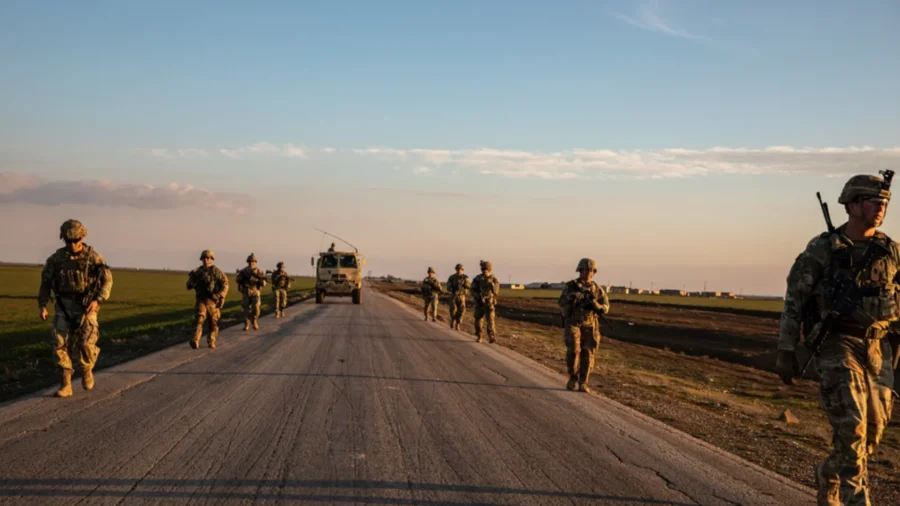U.S. troops stationed in Iraq and Syria have come under attack from rockets and explosive-laden one-way drones 55 separate times in the past month, according to deputy Pentagon press secretary Sabrina Singh.
At a Tuesday press conference, Ms. Singh announced there had been 27 attacks directed at U.S. troops in Iraq and 28 directed at U.S. troops in Syria since Oct. 17.
The Deputy Pentagon press secretary said these attacks have resulted in 59 injuries, including at least 27 U.S. personnel who have sustained traumatic brain injuries and 32 more injured with “other non-serious injuries.” So far, no U.S. personnel have been killed in this pattern of rocket and drone attacks.
“As of today, all 59 have returned to duty,” Ms. Singh announced.
Ms. Singh and other U.S. defense officials have attributed these rocket and drone attacks on U.S. forces in Iraq and Syria to various Iran-aligned factions that are active in the region. U.S. forces have, in response, conducted three separate air strikes targeting facilities in eastern Syria that they suspect have been used by Iran’s Islamic Revolutionary Guard Corps (IRGC) in support of these attacks.
On Sunday, Nov. 12, Secretary of Defense Lloyd Austin announced the most recent U.S. strikes targeted a suspected training facility in the eastern Syrian city of Abu Kamal, and a suspected safe house in the town of Mayadin.
Deterrence and Wider Regional Conflict
This recent pattern of attacks on U.S. troops in Iraq and Syria has come about after Hamas gunmen stormed into southern Israel from the Gaza Strip and killed at least 1,400 people on Oct. 7. As the Israeli military has carried out a retaliatory military campaign throughout the Gaza Strip in the weeks since the Oct. 7 attacks, the United States has deployed additional military resources to deter additional attacks on Israel and a broader conflict throughout the Middle East.
During the Pentagon press briefing, Ms. Singh insisted the attacks on U.S. troops in Iraq and Syria are a “separate issue” from the ongoing Israel–Hamas conflict, and expressed that the Pentagon believes the Israel–Hamas conflict remains contained. As far as the strikes against U.S. troops in Iraq and Syria implicate Iran, Ms. Singh said Iran has long opposed the U.S. presence in those countries and noted U.S. forces have come under attack from Iran-linked groups prior to the Oct. 7 Hamas attacks.
“We saw this back in March. We’ve seen this before, where they attack our forces,” Ms. Singh said of the recent attacks by these groups.
U.S. and Israeli officials have identified no direct Iranian link to the planning of the Oct. 7 Hamas attacks, but Iranian leaders did cheer the attacks and U.S. officials have historically accused Iran of arming Hamas, Hezbollah, and other Islamic factions to carry out destabilizing attacks throughout the Middle East.
During the Tuesday press briefing, Voice of America reporter Carla Babb noted the recent rocket and drone attacks against U.S. troops in Syria and Iraq have continued despite these three U.S. response strikes against suspected IRGC-linked facilities. Ms. Babb asked if the U.S. strikes were having a deterring effect.
“I think we are being very deliberate on how we and when we conduct our strikes against these groups. And I think that Iran is certainly seeing that message,” Ms. Singh replied.
Response to US Drone Downed By Houthis
Fox News reporter Jennifer Griffin separately questioned the efficacy of U.S. military deterrence in the Middle East after Yemen-based Houthis shot down a U.S. MQ-9 Reaper drone off the coast of Yemen last week. Ms. Griffin noted there has been no U.S. response against the Houthis since that drone was shot down last week and asked if this lack of response is inviting more aggression from them.
Ms. Singh again suggested a U.S. response to the Houthis could be forthcoming, but declined to say so with certainty or provide specifics.
“I’m not saying that we’re not going to respond. We always reserve the right to respond at a time and place of our choosing, but I just don’t have anything to forecast for you right now,” Ms. Singh said.
The Houthis, also known as Ansrallah, are a Zaydi Shiite movement that has intermittently fought with Yemen’s internationally recognized government since 2004. The conflict expanded after the Houthis took over the Yemeni capital of Sanaa in September 2014, bringing on a civil war that has seen Saudi Arabia and other gulf states intervene on behalf of the Yemeni government. The U.S. State Department has assessed Iran to be actively supplying the Houthi side with advanced weapons.
The Trump administration had designated the Houthis as a foreign terrorist organization during his last days in office, but President Joe Biden reversed that designation in February of 2021.
In addition to downing the U.S. drone on Wednesday, the Houthis have also recently waded into the ongoing Israel–Hamas conflict, claiming to have launched ballistic missiles and one-way drones at Israel.

